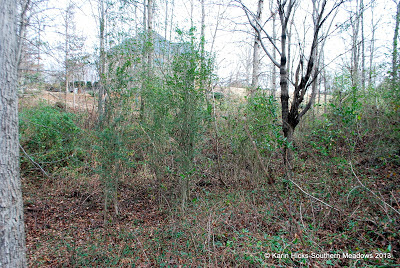Lessons Learned: Winter 2013
Winter is the time for comfort
for good food and warmth
for the touch of a friendly hand
and for a talk beside the fire:
it is the time for home.
~Edith Sitwell
The winter season is almost behind us. Once again the season seems to have speed by and I will miss the comfort food, cozy fireside family nights and interior decorating time. Signs of spring are all around so now is a good time to look back and see what lessons were learned before the busy gardening time begins. I am joining Plant Postings for a seasonal look back.
One of our winter activities has been liberating our newly acquired two acres, of invasive plants, mostly Japanese honeysuckle and privet, that have overrun the place. I need to give most of the credit to my husband who has been working tirelessly each weekend. Here are some before shots:
All the green is either privet or Japanese honeysuckle. Some of the privet is so big it requires a chain saw to cut down.
Here is an after shot of one section. There is still much more to do but this is progress! I am very excited to see how this space will evolve now that the native plants have room to breathe. And our dogs are thrilled to have more space to run and roam.
I highly recommend the exercise of removing invasive species from the landscape whether it is on your own property or as a volunteer effort at your local nature reserve or park. This activity gives one a new appreciation for the importance of native plants or better yet getting the word out about the harm invasive species can do. Take a look at how the Japanese honeysuckle has wrapped itself around the Devil's Walking Stick, a wonderful native understory plant.
An ounce of prevention is worth a pound of cure
National Invasive Species Awareness Week is March 3rd -8th. One of the most helpful learning experiences for me was/is learning to identify invasive plants. One of my favorite handbooks is Native Alternatives to Invasive Plants published by the Brooklyn Botanic Garden. It is a plant this, not that style book, providing several native alternatives for each invasive species.
This winter we have been going through a lot of bird seed. January and February felt colder than years past and if the birds foraging habits are cues about the weather then they confirm my thoughts.
We had a great time participating in the Great Backyard Bird Count on a particularly cold weekend. However, this also enable us to see lots of birds who were out searching for food to keep warm. Here are a few of our regulars:
 |
| Yellow-bellied sapsucker |
 |
| Downy woodpecker |
 |
| same downy woodpecker this time posing for the camera |
 |
| Tufted titmouse cracking open sunflower shell |
 |
| female cardinal munching on suet |
We have ground feeders too, lots of finches and mourning dove. I learned that birds eating on the ground close together is not all that healthy because they can spread bacteria easily. Also, birds tend to poop before they take off so they contaminate the area where they are feeding.
To improve this situation it is best to provide platform feeders for these ground feeding birds. (Note to hubby: please build platform feeder for the birds)
Did you know that goldfinches and pine siskins just suck the oil out of the niger seeds and don't actually eat the seeds? Neither did I. Niger seeds contain 35% fat, 18% protein, 18% fiber & 12% moisture. The protein helps the birds regenerate feathers when the birds molt in spring and fall. I have been attending some lunch and learn presentations this winter. I highly recommend taking advantage of your local resources such as nature centers, nurseries and libraries who host such events. They sure make winter pass by faster and also keep those little gardening brain cells energized!
Our two rufous hummingbirds are still enjoying the garden and they even shared a tree for a brief moment. One is sitting on a branch top right and the other lower down, bottom left. This was quite the capture because typically the female will chase the male off.
I listen for "my" hummers every day. She sings her "look at me, here I am" song. Since the cherry trees started to bloom I see them less frequently at the feeders and often fluttering about in the trees. I have grown really attached to these little ones and will really miss them when they depart on their migration.
What happened in your garden this winter? Any lessons worth sharing?
My next post will be looking forward to springtime activity with Donna at Gardens Eye View.






.png)
